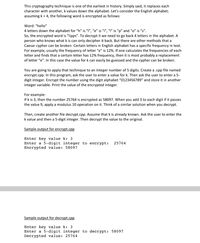
Database System Concepts
7th Edition
ISBN: 9780078022159
Author: Abraham Silberschatz Professor, Henry F. Korth, S. Sudarshan
Publisher: McGraw-Hill Education
expand_more
expand_more
format_list_bulleted
Question
C++ Nothing too advanced please. Learning the basics

Transcribed Image Text:This cryptography technique is one of the earliest in history. Simply said, it replaces each
character with another, k values down the alphabet. Let's consider the English alphabet;
assuming k = 4, the following word is encrypted as follows:
Word: "hello"
4 letters down the alphabet for "h" is "I", "e" is "i", "I" is "p" and "o" is "s".
So, the encrypted word is "lipps". To decrypt it we need to go back 4 letters in the alphabet. A
person who knows what k is can only decipher it back. But there are other methods that a
Caesar cypher can be broken. Certain letters in English alphabet has a specific frequency in text.
For example, usually the frequency of letter "e" is 12%. If one calculates the frequencies of each
letter and finds that a certain letter has 12% frequency, then it is most probably a replacement
of letter "e". In this case the value for k can easily be guessed and the cypher can be broken.
You are going to apply that technique to an integer number of 5 digits. Create a .cpp file named
encrypt.cpp. In this program, ask the user to enter a value for k. Then ask the user to enter a 5-
digit integer. Encrypt the number using the digit alphabet "0123456789" and store it in another
integer variable. Print the value of the encrypted integer.
For example:
If k is 3, then the number 25764 is encrypted as 58097. When you add 3 to each digit if it passes
the value 9, apply a modulus 10 operation on it. Think of a similar solution when you decrypt.
Then, create another file decrypt.cpp. Assume that k is already known. Ask the user to enter the
k value and then a 5-digit integer. Then decrypt the value to the original.
Sample output for encrypt.cpp
Enter key value k: 3
Enter a 5-digit integer to encrypt:
Encrypted value: 58097
25764
Sample output for decrypt.cpp
Enter key value k: 3
Enter a 5-digit integer to decrypt:
Decrypted value: 25764
58097
Expert Solution
This question has been solved!
Explore an expertly crafted, step-by-step solution for a thorough understanding of key concepts.
This is a popular solution
Trending nowThis is a popular solution!
Step by stepSolved in 2 steps with 2 images

Knowledge Booster
Learn more about
Need a deep-dive on the concept behind this application? Look no further. Learn more about this topic, computer-science and related others by exploring similar questions and additional content below.Similar questions
- (Intro to Java)arrow_forwardWhat are the pros and cons of debugging using manual walkthroughs as opposed to print statements? Discuss?arrow_forwardWhat is a standard library? A. A library created by the programmer B. Libraries included as part of the C++ language C. Libraries that include blueprints of classes D. There are no standard librariesarrow_forward
- How do I learn coding? I want to learn c++ but I don't know what to write. Like I know there is something called a while loop but what is it and what does it do? Do you know any books or websites which can help?arrow_forwardHey thank you for your answer. I would like to know the main C++ modules that I need to know/understand to complete this program myself. i.e (Classes, structures, arrays, strings...) Please let me know the exact modules so I can study them as soon as possible. Thank you.arrow_forwardC++ What one topic did you learn about that was most noteworthy What was your favorite topic? What was your least favorite topic? Why? What other topics (s) would you like to see covered in this course(c++)? What topic(s) would you like to see removed from the course?arrow_forward
arrow_back_ios
arrow_forward_ios
Recommended textbooks for you
 Database System ConceptsComputer ScienceISBN:9780078022159Author:Abraham Silberschatz Professor, Henry F. Korth, S. SudarshanPublisher:McGraw-Hill Education
Database System ConceptsComputer ScienceISBN:9780078022159Author:Abraham Silberschatz Professor, Henry F. Korth, S. SudarshanPublisher:McGraw-Hill Education Starting Out with Python (4th Edition)Computer ScienceISBN:9780134444321Author:Tony GaddisPublisher:PEARSON
Starting Out with Python (4th Edition)Computer ScienceISBN:9780134444321Author:Tony GaddisPublisher:PEARSON Digital Fundamentals (11th Edition)Computer ScienceISBN:9780132737968Author:Thomas L. FloydPublisher:PEARSON
Digital Fundamentals (11th Edition)Computer ScienceISBN:9780132737968Author:Thomas L. FloydPublisher:PEARSON C How to Program (8th Edition)Computer ScienceISBN:9780133976892Author:Paul J. Deitel, Harvey DeitelPublisher:PEARSON
C How to Program (8th Edition)Computer ScienceISBN:9780133976892Author:Paul J. Deitel, Harvey DeitelPublisher:PEARSON Database Systems: Design, Implementation, & Manag...Computer ScienceISBN:9781337627900Author:Carlos Coronel, Steven MorrisPublisher:Cengage Learning
Database Systems: Design, Implementation, & Manag...Computer ScienceISBN:9781337627900Author:Carlos Coronel, Steven MorrisPublisher:Cengage Learning Programmable Logic ControllersComputer ScienceISBN:9780073373843Author:Frank D. PetruzellaPublisher:McGraw-Hill Education
Programmable Logic ControllersComputer ScienceISBN:9780073373843Author:Frank D. PetruzellaPublisher:McGraw-Hill Education

Database System Concepts
Computer Science
ISBN:9780078022159
Author:Abraham Silberschatz Professor, Henry F. Korth, S. Sudarshan
Publisher:McGraw-Hill Education

Starting Out with Python (4th Edition)
Computer Science
ISBN:9780134444321
Author:Tony Gaddis
Publisher:PEARSON

Digital Fundamentals (11th Edition)
Computer Science
ISBN:9780132737968
Author:Thomas L. Floyd
Publisher:PEARSON

C How to Program (8th Edition)
Computer Science
ISBN:9780133976892
Author:Paul J. Deitel, Harvey Deitel
Publisher:PEARSON

Database Systems: Design, Implementation, & Manag...
Computer Science
ISBN:9781337627900
Author:Carlos Coronel, Steven Morris
Publisher:Cengage Learning

Programmable Logic Controllers
Computer Science
ISBN:9780073373843
Author:Frank D. Petruzella
Publisher:McGraw-Hill Education